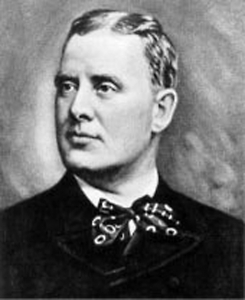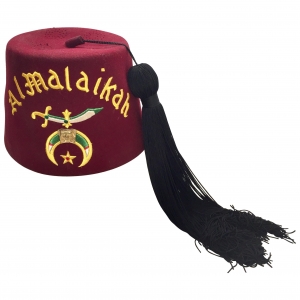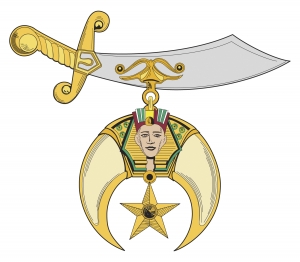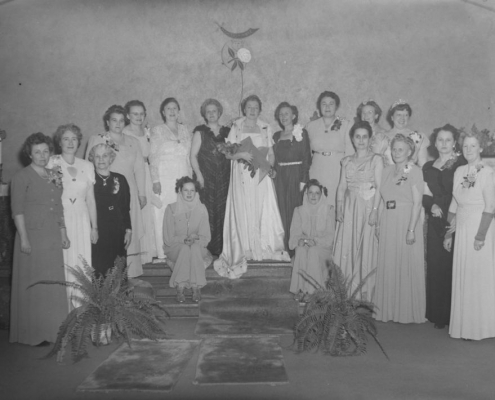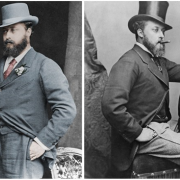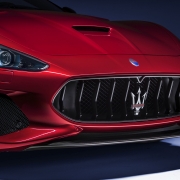The Shriners, aka The Ancient Arabic Order of the Nobles of the Mystic Shrine.
In 1870, a group of Freemasons met regularly for lunch at the Knickerbocker Cottage on Sixth Avenue in New York City. At a special table on the second floor, a particularly cheerful group of men met regularly. Among the regulars were Walter M. Fleming, M.D., and William J. "Billy" Florence, an actor. The group often talked about starting a new Masonic fraternity - one that focused on fun and fellowship, rather than ritual. Fleming and Florence took this idea seriously enough to do something about it.
Knickerbocker Cottage on Sixth Avenue in Manhattan
Billy Florence had been on tour in France and was invited to a party given by an Arab diplomat. The exotic style, flavours and music of the Arab-themed party inspired him to propose this as the theme for the new fraternity. Walter Fleming, a dedicated brother, built on Florence's ideas and used his knowledge of fraternal rituals to transform the Arabic theme into the Ancient Arabic Order of Nobles of the Mystic Sanctuary (A.A.O.N.M.S.). With the help of the regulars of Knickerbocker Cottage, Fleming drew up the ritual, designed the emblem and costumes, formulated an invocation and declared that members would wear the red fez.
William Jermyn Conlin (26 July 1831 - 19 November 1891) better known by his stage name William J. Florence, was an American actor, songwriter and playwright. He achieved national prominence with a forty-year career in which he excelled in playing the humorous and poetic Irish character.
Florence received ribbons for his œuvre from the French Societe Histoire Dramatique.
Florence was invited to a party given by an Arab diplomat during a tour in Marseille.
The entertainment was something in the nature of an elaborately staged musical comedy.
Afterwards, the guests became members of a secret society.
Florence made many notes and drawings on his first visit and on two other occasions, once in Algiers and once in Cairo.
When he returned to New York in 1870, he showed his material to Fleming.
Walter Millard Fleming (1838 - 1913) was a prominent physician and surgeon. He received a degree in medicine in Albany, New York, in 1862.
During the Civil War, he was a surgeon in the 13th New York Infantry Brigade, a militia unit of what would later be called the National Guard. He then practised medicine in Rochester, New York, until 1868, when he moved to New York City and became a prominent practitioner.
Fleming created the ritual, the emblem and the costumes. Florence and Fleming were initiated on 13 August 1870, and on 16 June 1871 they began with 11 other men. The group adopted a Middle Eastern theme and soon established Temples (although the term Temple is now generally replaced by Shrine Auditorium or Shrine Centre).
The first temple founded was the Mecca Temple (now known as Mecca Shriners), established on September 26, 1872 at the New York City Masonic Hall. Fleming was the first Potentate. Fleming is listed as member #1 in the 1904 Report of Mecca Temple, New York City.
The red fez with a black tassel, the official headgear of the shrine, has been handed down through the ages.
It takes its name from the place where it was first made - the holy city of Fez, Morocco.
The Fez became a symbol of the Ottoman Empire in the early 19th century.
In 1827, Mahmud II commissioned the Fez as a modern headdress for his new army, the Asakir-i Mansure-i Muhammediye.
The decision was inspired by the Ottoman naval command, which had earlier returned from the Maghreb and embraced the style. In 1829, Mahmud issued new regulations requiring the use of the Fez by all civil and religious officials.
It was intended to replace the turban, which acted as a marker of identity, dividing rather than uniting the population.
The fez was subsequently banned in Turkey in 1925 as part of Atatürk's reforms.
The Logo
The crescent was adopted as the jewel of the Order.
Although any material can be used to form the Crescent Moon, the most valuable are the claws of a royal Bengal tiger, united at their base in a gold setting. In the middle is the head of a sphinx and on the back a pyramid, an urn and a star. The jewel bears the motto, "Robur et Furor", which means "Strength and Fury". Today, the shrine's emblem includes a scimitar from which hangs the crescent moon, and a five-pointed star under the sphinx's head.
The emblem on the front of the fez, the half-moon and scimitar, is an important part of the brotherhood's theme and is representative of the characteristics embodied by the Shriners. The scimitar represents the backbone of the brotherhood, its members. The two claws represent the Shriners brotherhood and its philanthropy. The sphinx represents the governing body of the Shriners and the five-pointed star represents the thousands of children helped by the philanthropy each year.
The first meeting
On September 26, 1872, the first Shrine Temple in the United States was held in the New York City Masonic Hall. Brother McClenachan and Dr Fleming had completed the ritual and proposed that the first temple be called Mecca. The original 13 Masons of the Knickerbocker Cottage lunch group were called Charter Members of Mecca Temple (Mecca Shriners). Noble Florence read a letter outlining the 'history' of the Order and giving advice on holding meetings. The elected offices were Walter M Fleming, Potentate; Charles T. McClenachan, Head Rabban; John A Moore, Assistant Rabban; Edward Eddy, High Priest and Prophet; George W. Millar, Oriental Guide; James S. Chapel, Treasurer; William S. Paterson, Recorder; and Oswald M. d'Aubigne, Captain of the Guard.
But the organisation was not an immediate success, although in 1875 a second temple was chartered in Rochester. Four years after the sanctuary began, there were only 42 Shriners, all but six from New York.
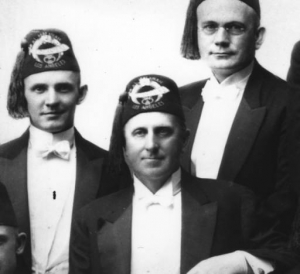
At a meeting of Mecca Shriners on 6 June 1876, in the New York Masonic Temple, a new body was crated to stimulate the growth of the young brotherhood. This governing body was called "The Imperial Grand Council of the Ancient Arabic Order of Nobles of the Mystic Shrine for the United States of America". Fleming became the first Imperial Grand Council and the new body established rules for membership and the formation of new temples. The initiation ritual was embellished, as was the mythology of the brotherhood. An extensive publicity and recruitment campaign was launched.
It worked. Just two years later, in 1878, there were 425 Shriners in 13 temples. Five of the temples were in New York, two in Ohio and the others in Vermont, Pennsylvania, Connecticut, Iowa, Michigan and Massachusetts.
The sanctuary continued to grow throughout the 1880s. By the time of the 1888 annual meeting (convention) in Toronto, there were 7,210 members in 48 temples across the United States and one in Canada. Although the organisation was still primarily social, philanthropic activities became increasingly common. During a yellow fever epidemic in 1888 in Jacksonville, Florida, members of the New Moro Shriners and Masonic Knights Templar worked long hours to relieve the suffering population. In 1889, Shriners came to the aid of the victims of the Johnstown Flood. In 1898, there were 50,000 Shriners and 71 as the 79 Temples engaged in a kind of philanthropic work.
By the turn of the century, the Shriners had come into their own. During the Imperial Coucil of 1890, representatives from 82 temples marched in a parade in Washington, DC, judged by President William McKinley. The number of Shriners was over 55,000. By 1938, there were approximately 340,000 members in the United States. That year, Life first published photographs of their rites. It described the Shriners as "among the secret lodges the number one in prestige, wealth and show," and stated that "in the typical city, especially in the Midwest, the Shriners will comprise most of the prominent citizens."
The present Order.
Shriners often take part in local parades, sometimes as rather elaborate units: miniature themed vehicles (all sports cars; all miniature 18-wheeler trucks; all fire engines, and so on), an "oriental band" dressed in cartoonish versions of Middle Eastern dress; pipe bands, drummers, motorbike units, Drum and Bugle Corps, and even traditional brass bands.
Membership
Until 2000, before being eligible for membership of the Shrine, a Mason had to complete either the Scottish Rite or the York Rite systems, but now any Master Mason can become a member.
In the past, Shriners have practised hazing rituals as part of initiating new members: in 1991, a potential Shriner sued the Oleika Shrine Temple of Lexington, Kentucky for injuries sustained during hazing, including being blindfolded and a shock of electricity applied to his bare bottom.
There are two organisations attached to the Shrine that are for women only: The Ladies' Oriental Shrine and the Daughters of the Nile. They both support the Shriners' shrines and promote sociability, and membership in both organisations is open to any woman aged 18 or over who is related by birth or marriage to a Shriner or Master Mason.
The Ladies Oriental Shrine of North America was founded in 1903 in Wheeling, West Virginia,[10] and the Daughters of the Nile was founded in 1913 in Seattle, Washington.
The latter organisation has local chapters called "Temples", and there were ten in 1922.
Among the famous members of the Daughters of the Nile was First Lady Florence Harding, wife of Warren G. Harding.
Architecture
Some of the earliest temples often chose a Moorish revival style for their temples. Architecturally notable Shriners temples include: the Shrine Auditorium in Los Angeles; the former Mecca Temple, now called New York City Center and used primarily as a concert hall; Newark Symphony Hall; the Landmark Theatre (formerly The Mosque) in Richmond, Virginia; the Tripoli Shrine Temple in Milwaukee, Wisconsin; the Polly Rosenbaum Building (formerly the El Zaribah Shrine Auditorium) in Phoenix; the Helena Civic Centre (Montana) (formerly the Algeria Shrine Temple); Abou Ben Adhem Mosque in Springfield, Missouri; Murat Shrine Temple (now Old National Center) in Indianapolis; the Fox Theatre (Atlanta, Georgia) which was jointly built by the Atlanta Shriners and film magnate William Fox; and the Syria Mosque, Pittsburgh, Pennsylvania.
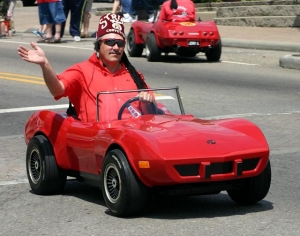
Most temples support various parade units. These units are responsible for promoting a positive Shriner image to the public by participating in local parades.
The parade units often include miniature cars powered by lawn-mower engines.
There is no great history or ritual behind it. It is pure entertainment for the children.
To stand out in parades, the Shriners started wearing elaborate costumes and driving small cars designed more for tricks than speed. Car and Driver magazine even examined the cars to see what it was all about. These "modern go-karts" cost about $1,600 each.
The Shriners are so secretive about where the cars were made that the author of the article could only discover that they were built somewhere in Illinois.
Shriners in St. Louis have several parade engine units, including miniature cars modelled after 1932 Ford coupes and 1970s Jeep CJ models, and a unit of Indianapolis-style miniature race cars. Some of these are equipped with powerful alcohol-powered engines. The drivers' skills are demonstrated in parades with fast spinouts.
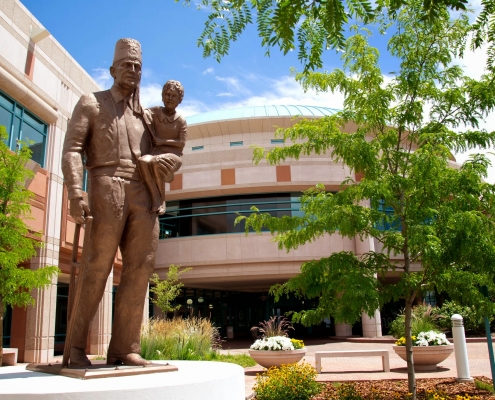
Shriners Hospitals Shriners Hospitals for Children is a network of 22 non-profit medical facilities across North America. Children with orthopaedic conditions, burns, spinal cord injuries and cleft lip and palate are eligible for care and receive all services in a family-oriented setting, regardless of the patient's ability to pay. Care for children is usually provided until the age of 18, although in some cases it can be extended to the age of 21.
In 1920, the Imperial Session of the Shriners was held in Portland, Oregon. At that session, the members unanimously adopted a resolution introduced by W. Freeland Kendrick, who (while serving as Imperial Governor) put forward the resolution that established the Shriners Hospitals for Children. The first hospital in the system opened in 1922 in Shreveport, Louisiana. It provided pediatric orthopaedic care. Shriners Hospitals for Children worked closely with the United States Southern Command and other military commands, including the Army and Air Force, the Guatemalan Combined Forces, and through the US Embassy, the US Department of Health and Human Services and the US State Department to arrange medical visas and transportation to the United States, "with a global commitment to children around the world".
In 1962, the Shriners of North America gave $10 million to establish three hospitals specialising in the treatment and rehabilitation of burnt children. After visiting 21 university medical institutions, the decision was made to build their first paediatric burn hospital on the campus of the University of Texas Medical Branch in Galveston, Texas.
In 1994, the Chronicle of Philanthropy, an industry publication, published the results of the largest survey of the popularity and credibility of charities and non-profit organisations. The study found that Shriners Hospitals was ranked as the 9th "most popular charity/non-profit in America" of more than 100 charities surveyed, with 40% of Americans over the age of 12 choosing "Love" and "Like A Lot" for Shriners Hospitals.
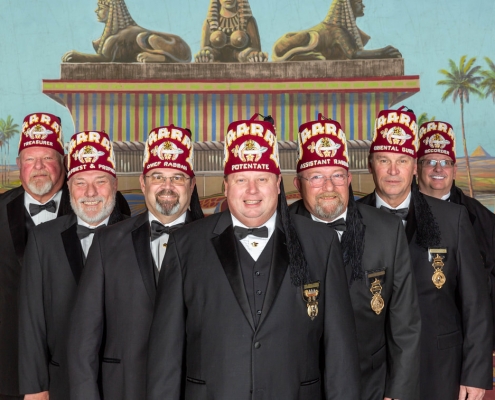
In 2009, Douglas Maxwell, the hospitals' CEO, said he and other Shriners are confident that the hospital system will remain solvent in 2009, despite an endowment that dropped from $8 billion to $5 billion in less than a year because of the poor economy. long-term. Maxwell stated in July 2009 that some of the facilities may become outpatient surgery centres and will start accepting insurance payments (for most care) for the first time in the 87-year history of the hospitals. Maxwell said that children suffering from burns, orthopaedic conditions, spinal cord injuries and cleft palates will be treated at no cost to their families.
In May 2015, Shriners Hospitals for Children became a member of the Mayo Clinic Care Network, a national network of organisations committed to improving services for patients and their families through physician collaboration.
More information about The Shriners can be found here: www.shrinersinternational.org
More information about The Shriners Hospitals can be found here: www.shrinershospitalsforchildren.org
Thierry Stravers is co-owner of Masonic Store.
He likes to combine his passion for style and elegance with his Masonic activities.
Thierry is the owner of Trenicaa marketing agency and is a board member of Loge Enlightenment No.313 O: Hoofddorp.

